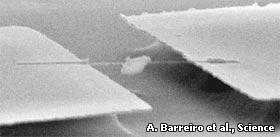Back in 2005, I reported that monorailists were threatening to weave nanomonorails into our clothing. At the time these nanomonorails were constructed using nanobiotechnology adapted from Black Helicopter research. The Monorailists used ATP and kinesin, two biological molecules found in our cells, thus making a nanomonorail that was a sort of human/nanomonorail chimera -- a "manomonorail", if you will.
Now Monorailsts in Spain -- presumably following some sort of disagreement with the Black Helicopter nanobiotechnicians -- have devised a new form of non-biological nanomonorail technology which they claim has the theoretical ability to move 100 million times faster than those using biological motor proteins.
Both the rail and the shuttle of their nanomonorail are built from carbon nanotubes, the car sliding over the rail like a sleeve. Movement comes from thermomechanical action instead of through a perversion of biology:
They attached each end of the nanotube track, about 300 nanometres long, to metal platforms, so that the tube stretched between them through empty space. Then they fixed a flake of gold to the shuttle tube, which was intended to hold molecular cargo.
When the researchers passed an electrical current through the bridging nanotube, which acts like a 'wire' connecting the metal plates, they found that some shuttle tubes moved towards the nearest plate. Others simply revolved at a fixed location.
"At first we thought it was the electrons that were moving the nanotube," says Bachtold. But the direction of motion didn't depend on the direction of the current.
Instead, the researchers concluded that the current was simply heating up the device, and that this was what was moving the shuttle. This mechanism "came as a surprise", says Bachtold.
Because heat is conducted out of the nanotube by the metal plates, the system is hottest in the middle and cooler at the ends. This means that the thermal shaking of the track tube is strongest in the middle -- which makes the sleeve tube move towards whichever end is nearer. It is a little like shaking the free end of a rope tied to a tree, with a hoop threaded onto the rope. The waves in the rope will usher the hoop towards the tree.
Fortunately for those dreading the day when nanomonorails bind the entire biosphere into a fine, homogeneous gray mesh, there's a major problem the Monorailists need to work out: their shuttle gets hot enough to destroy any cargo on board. Not surprising considering the same problem is too-often exhibited by macromonorails.

